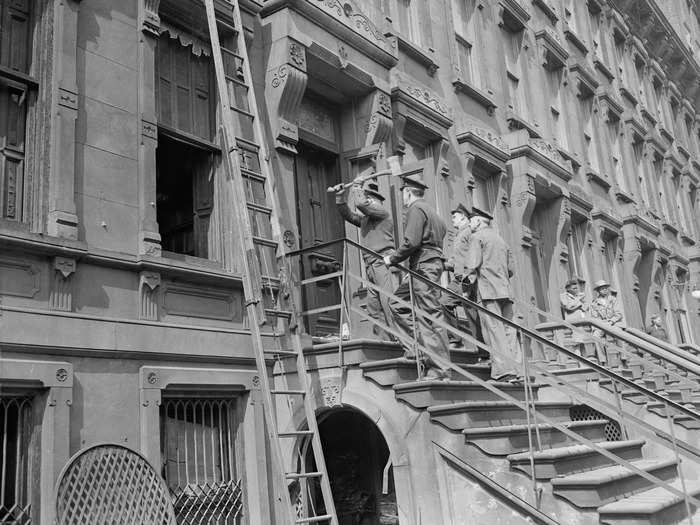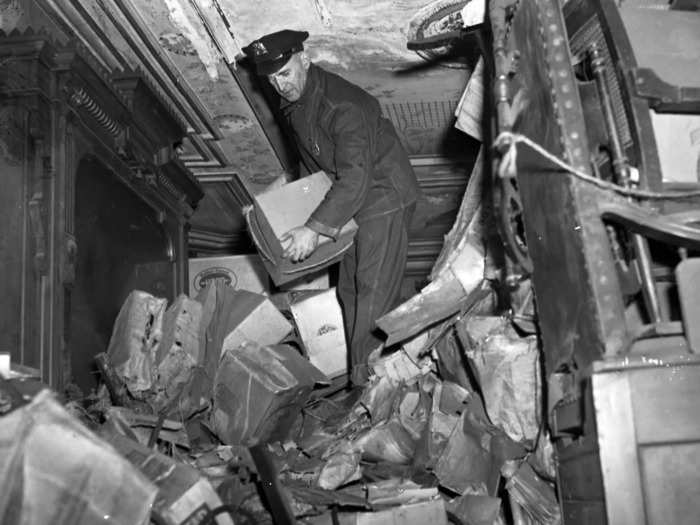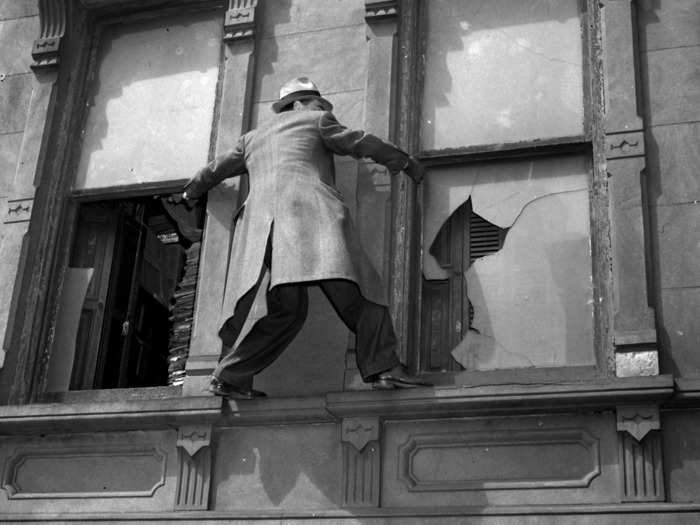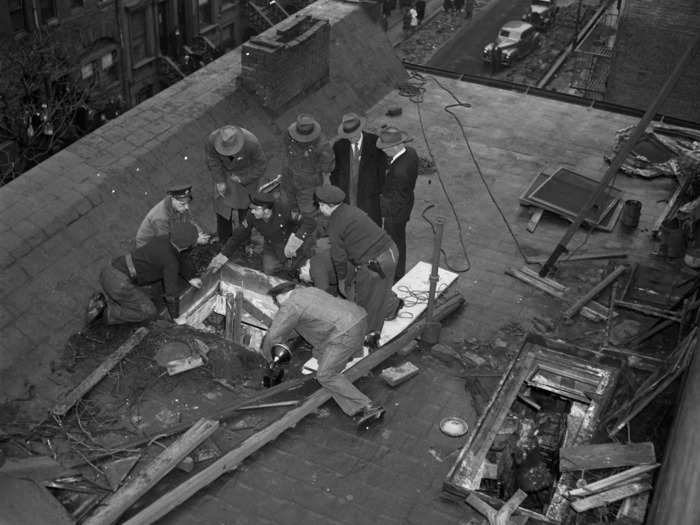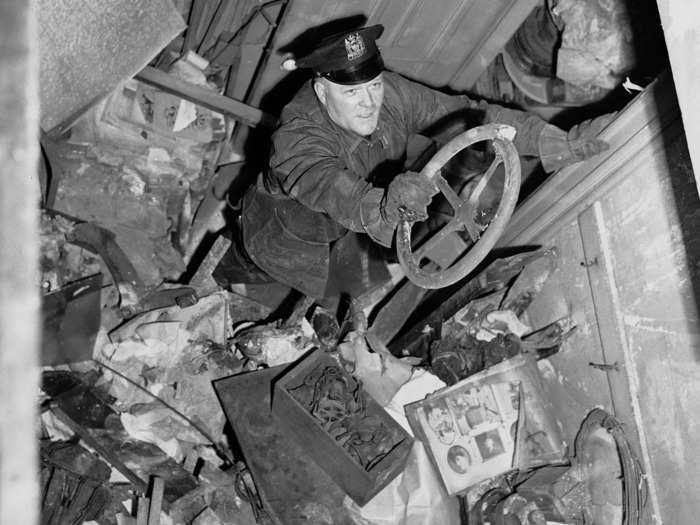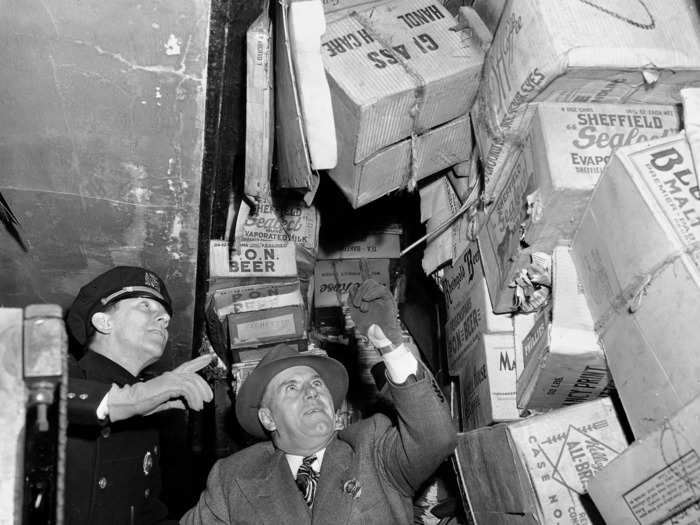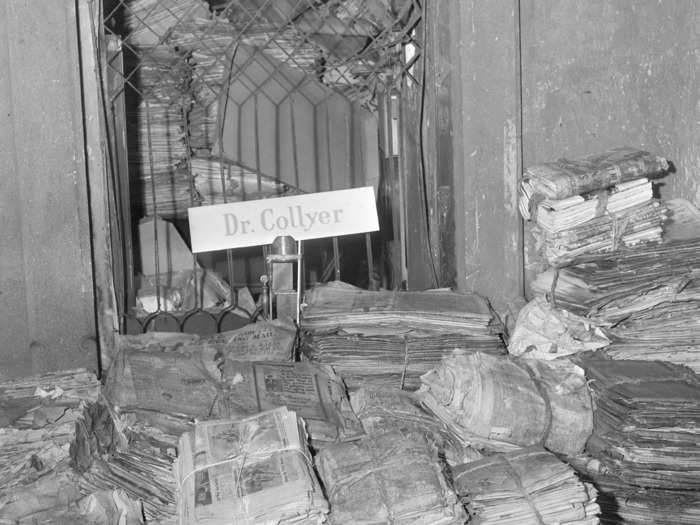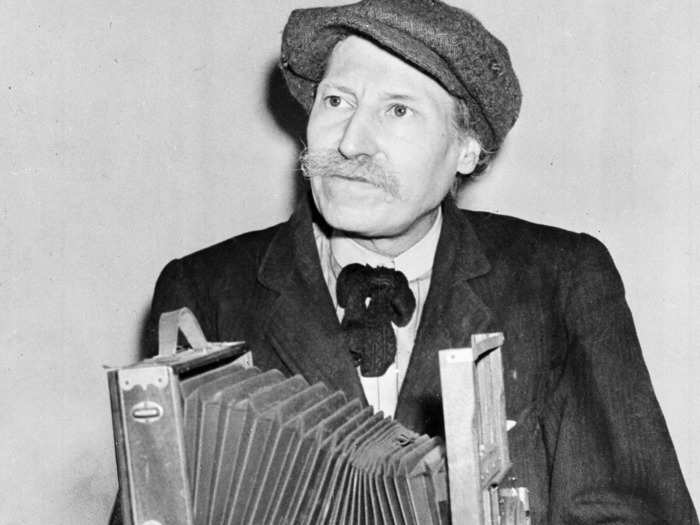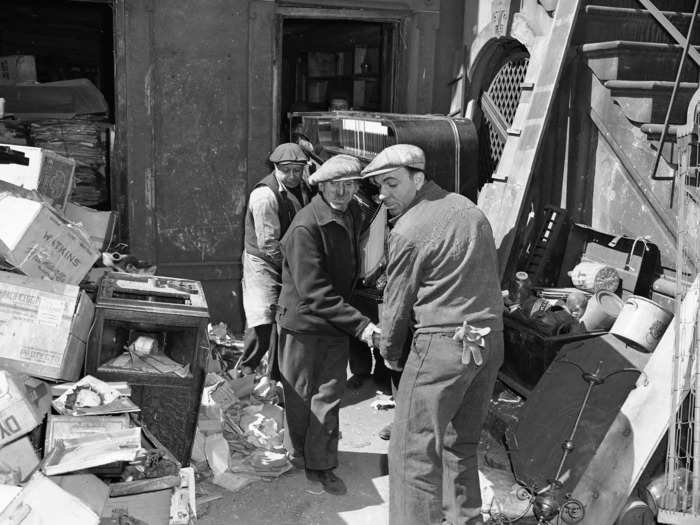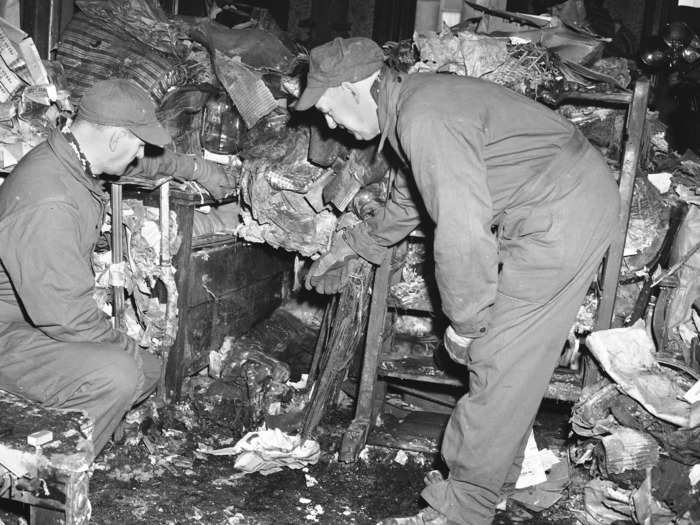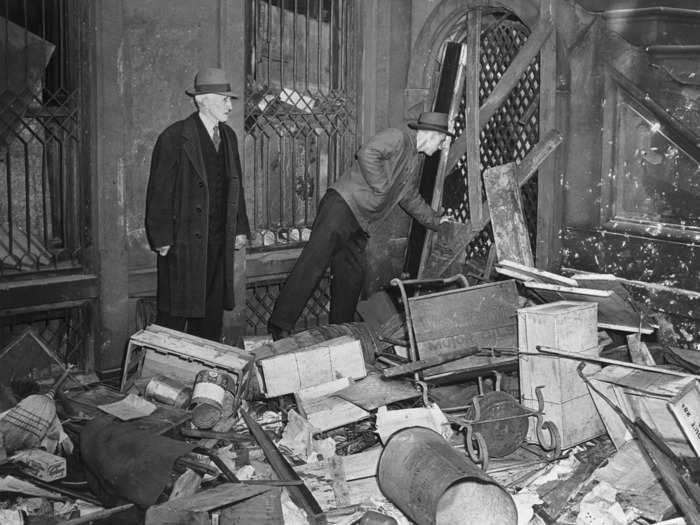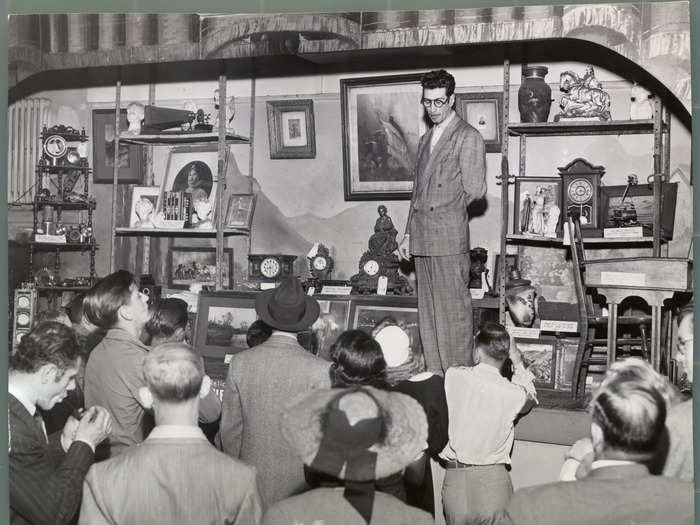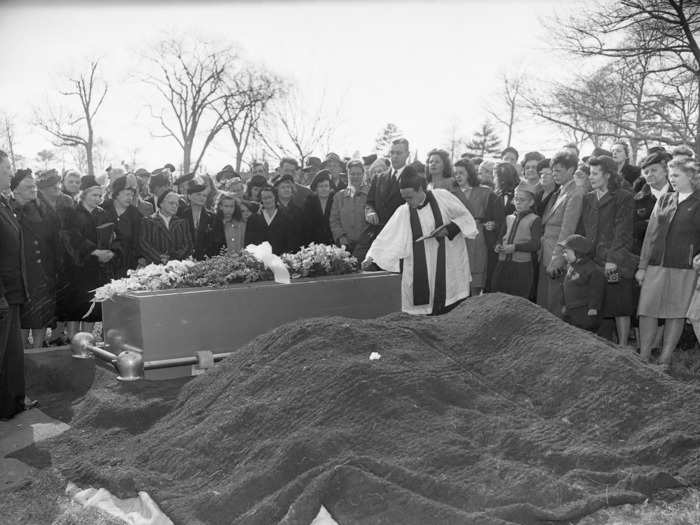A NYPD officer climbs over debris to enter the junk-filled library in the Collyer house.Anthony Camerano/ AP
- On March 21, 1947, an anonymous tip sent authorities to the Collyer brothers' mansion in Harlem.
- NYPD officers found the dead body of one of the brothers amongst 120 tons of trash they had collected.
On March 21, 1947, the New York Police Department received an anonymous tip complaining about a smell from 2078 Fifth Ave in Harlem. When the police arrived at the scene, they found 120 tons of garbage, a dead body, and a missing brother they suspected of murder.
Homer and Langley Collyer lived in a home in Harlem that they inherited after their parents' death. As the two grew older, they became reclusive to the point where they would rarely be seen outside their home.
Their three-story home in Harlem became filled with relics, trash, and hundreds of unread newspapers. When the NYPD arrived at the Collyer home, there was so much trash that police had to enter through the second-story window and make a hole in the roof.
Homer died in his home on March 21 due to starvation and a heart attack. The elder brother was blinded after a stroke years prior and had become paralyzed from rheumatism.
Langley, his younger brother and caretaker, was found half a month later, buried under a pile of garbage 10 feet away from Homer's body. Police suspected that Langley died after tripping one of the many booby traps he set up throughout his home.
Here's the story of two brothers who turned away from the outside world and created a palace from what they collected off the streets.
On March 21, 1947, New York police responded to an anonymous call at 2078 Fifth Ave in Harlem.
New York Police officers break down the door of the Collyer's apartment. Getty Images
The apartment was so filled with garbage that the police had to knock the door down with an axe.
Despite successfully knocking out the front door, police had no choice but to start clearing the debris they found inside if they wanted to get in.
The NYPD tries to navigate around the mass of trash inside the Collyer mansion. Getty Images
To expedite the process, the police eventually broke a window on the second story and entered the apartment.
A detective tries to enter the broken windows on the second story of the Collyer Mansion. Getty Images
They also made a hole in the roof of the building to enter from above to work around trash barriers.
Officers create a hole in the roof to try to gain access to the Collyer mansion. Getty Images
Once inside, police were met with piles of garbage that went up to the ceiling and tunnels that wove through the trash so the Collyers could move around more easily.
New York City police officer holds up a decaying auto steering wheel found while searching the Collyer mansion Harry Harris/AP
Langley Collyer, who had earned a degree in engineering, was so paranoid about people stealing their collection that he rigged the place with booby traps.
Lt. Ed Stanley and Deputy Inspector Tom Boylan point to a “booby trap” box in the rubbish-cluttered Collyer mansion in New York Anthony Camerano/AP
Parts of a Model T Ford were among the trash found in the apartment. Langley had taken it apart and reconstructed it inside the apartment to use as a generator when their gas and electricity were shut off years prior.
Amongst all the junk, authorities finally found the body of Homer Collyer.
Newspapers collected by Langley for his brother Homer Getty Images
Morticians estimated that he had been dead for 10 hours by the time he was found and died from starvation and a heart attack.
Langley fed Homer a diet of 100 oranges a week because he believed it would bring back his eyesight.
He kept the newspapers for Homer to catch up on the news when he regained sight.
Once Homer was found, Langley was still unaccounted for. As a result, authorities believed Langley murdered his brother and left town.
A portrait of Langley Collyer. New York Herald Tribune/AP
In the meantime, authorities cleared out the rest of the mansion and the 120 tons of trash inside.
Workers move a piano out of Collyer mansion. Joe Caneva/AP
Amongst the piles of trash, authorities found 14 grand pianos, an old generator, parts of a Model T Ford, more than 3,000 books, pictures of pin-up girls, thousands of empty bottles and cans, and dressmakers dummies.
Langley, a former pianist, would reportedly play the piano for his blind and paralyzed brother.
Half a month after clearing out the garbage, officers found the body of Langley — just 10 feet from where they found his brother.
Detectives bend over to examine the body of Langley Collyer in the rubbish-cluttered upper Fifth Avenue mansion John Lindsay/AP
When authorities found Langley's body, it was buried under a suitcase, three metal bread boxes, and bundles of newspapers he had connected to a trigger to trap intruders.
Langley died first after succumbing to the booby traps he set up to protect him and his brother. Homer, unable to see or move, died afterward.
After their death, relatives and people claiming to be relatives appeared in an attempt to gain money from the estate.
William Collyer, left, and his son G. Douglas Collyer amid the rubble outside the cluttered brownstone house on 5th Ave. Getty Images
Relatives even showed up to stop authorities from throwing away anything of value.
In total, 56 claimants attempted to get a piece of the estate over five years. In the end, 23 of them were successful, all of whom were cousins.
All cousins shared an estimated $31,000 equally, which is about $442,689 in value today.
The rest was auctioned to wanderers who were coming in off the street.
An auctioneer helps sell the Collyer brothers items. Getty Images
The brothers were buried together in Cyprus Hill Cemetery in Brooklyn.
A Reverend performs a funeral ceremony for the Collyer brothers. Getty Images

